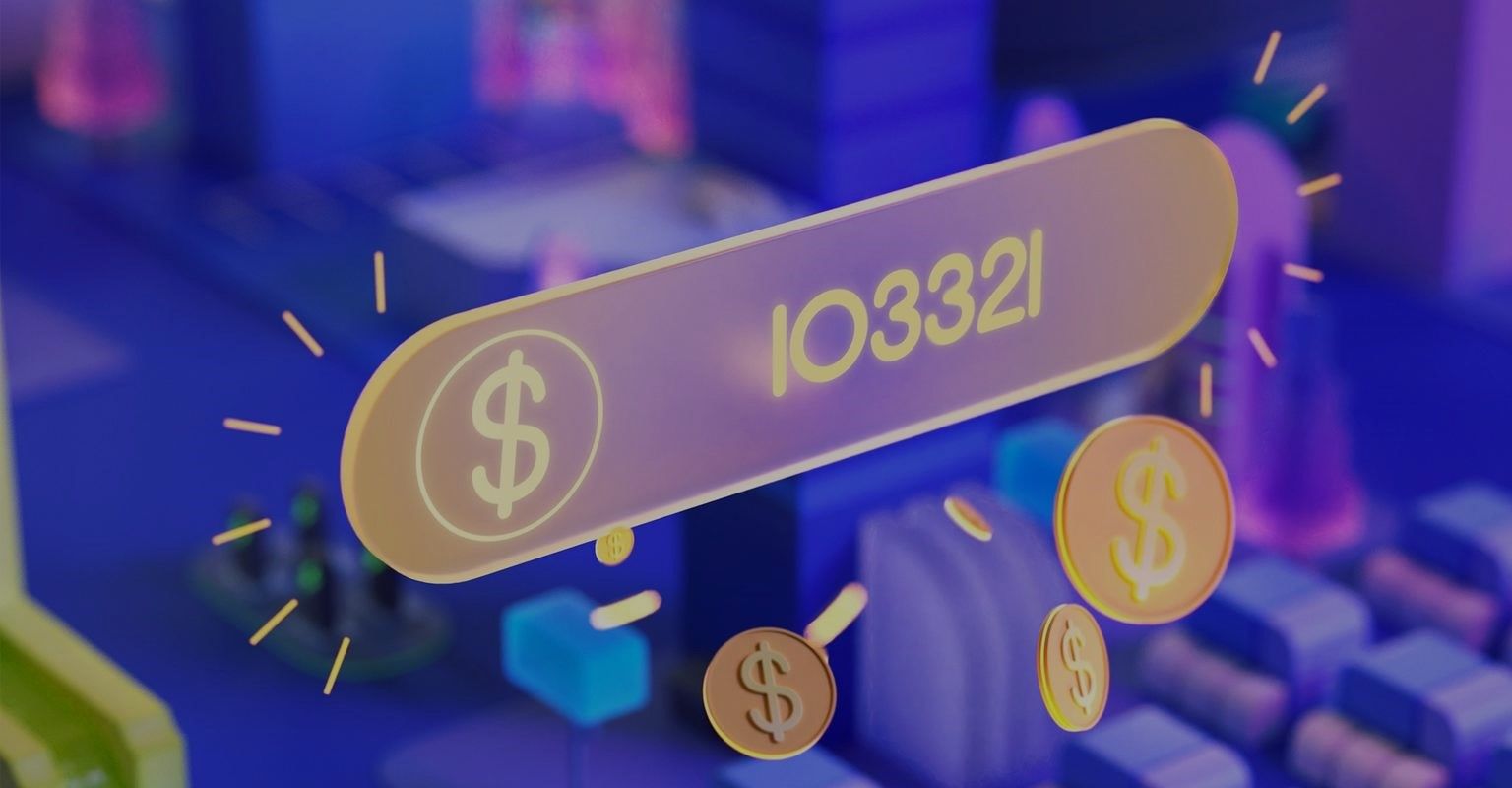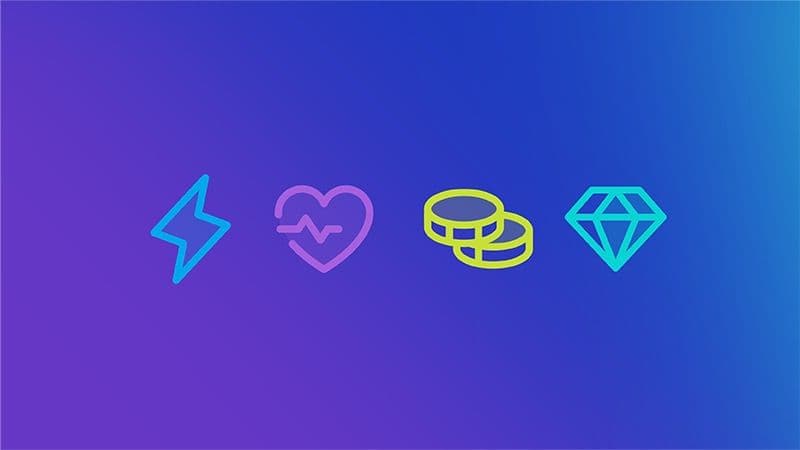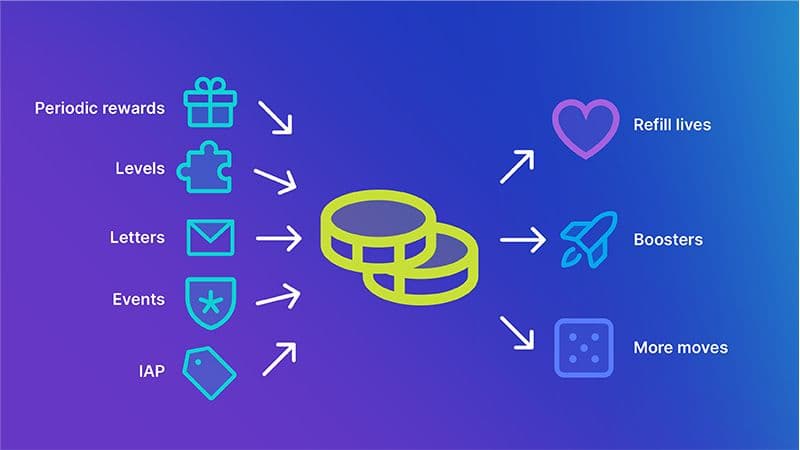
Se você puder equilibrar suas fontes e sumidouros de forma eficaz, mantendo seus jogadores no ponto ideal entre o tédio e a frustração, eles não ficarão ressentidos com sua mecânica econômica – eles serão motivados por ela, e seu jogo será muito melhor por isso.

Considere um jogo de fusão que gira em torno da construção de um império de casas onde há dois tipos de recursos: Casas e moedas. As casas seriam o recurso que indicaria a progressão do jogador, e as moedas seriam a moeda que tornaria todas as transações no jogo possíveis.
Na realidade, os jogos apresentam um conjunto muito diversificado de moedas de acordo com sua complexidade. Os mais comuns são energia, vidas, moeda fraca e moeda forte.
Energia se refere à quantidade máxima de resistência que um jogador pode sustentar antes de perder uma vida, enquanto vidas se referem a um número finito de tentativas totais antes do jogo terminar.
Para ajudar a desenvolver o hábito, você pode fazer com que os jogadores esperem um certo tempo antes que suas vidas sejam repostas. Você também pode limitar o número de vidas que os jogadores podem ter por vez, o que limita a duração de uma sessão de jogo e incentiva os jogadores a retornar.
Encontrar o equilíbrio certo entre o tempo de espera e o limite de energia ou vidas será crucial para que os jogadores vivenciem o jogo da maneira que você planejou.
Moedas suaves são as moedas mais comumente encontradas em jogos gratuitos. Os jogadores podem ganhá-los facilmente e eles estão amplamente disponíveis nas recompensas do ciclo principal do jogo.
Por exemplo, os jogadores podem ganhar moedas ao terminar níveis, que podem ser usadas para comprar vidas, reforços ou outros recursos. Em outros casos, os jogadores podem usar essas moedas como método de buy-in para acessar determinados níveis.
Fornecer lugares atraentes o suficiente para os jogadores gastarem sua moeda fraca e encontrar o equilíbrio certo entre fontes e sumidouros impulsionará a monetização.
Moedas fortes, geralmente representadas por itens de alto valor, como pedras preciosas ou ouro, dão aos jogadores acesso a itens e recursos exclusivos.
Moedas fortes podem ajudar você a oferecer flexibilidade aos seus jogadores. Por exemplo, eles podem permitir que os jogadores acelerem sua progressão pulando etapas. Esta é uma consideração importante no design de jogos, pois permite que jogadores de diferentes níveis de habilidade se sintam motivados.
Moedas fortes são oferecidas por meio de compras no aplicativo feitas com dinheiro real, enquanto moedas fracas estão disponíveis por meio de compras virtuais feitas com moeda forte.

Ao construir sua economia, você deve considerar como as moedas e os recursos impactarão a progressão do jogador para garantir uma experiência divertida e tranquila.
As principais moedas do seu jogo sempre terão um impacto direto na progressão, assim como certos tipos de recursos. Se o objetivo do seu jogo é administrar uma fazenda, obter equipamentos agrícolas será crucial para que os jogadores avancem.
Outros recursos, como boosters, podem ter um efeito indireto, tornando a jogabilidade mais fácil. É útil oferecer aos jogadores diferentes opções para que o jogo possa ser aproveitado em diferentes níveis de dificuldade.

Depois de estabelecer as moedas e entender os recursos, é hora de identificar fontes e sumidouros.
As fontes incluem moedas ganhas em níveis, recompensas periódicas ou prêmios por completar eventos. Por outro lado, os sumidouros incluem o uso de moedas para recarregar vidas, comprar reforços ou obter movimentos extras para terminar um nível.
Tenha em mente que a maneira como você distribui recompensas e recursos entre diferentes fontes impacta a experiência do jogador, e que uma economia de jogo otimizada terá a soma das fontes equilibrada com a soma dos recursos.
Uma economia forte no jogo é muito mais do que monetização. É a força silenciosa por trás do envolvimento do jogador e pode definir como os jogadores progridem no jogo. Confira o primeiro guia desta série para aprender como criar uma economia de jogo que faça os jogadores voltarem para mais.
Não há dois jogadores iguais – sua economia deve levar isso em conta para garantir que todos os jogadores tenham uma experiência positiva com seu jogo. Confira o terceiro guia desta série para aprender a projetar pensando nos jogadores.

Com a Unity Economy, você pode criar uma economia personalizada no jogo e oferecer aos seus jogadores compras integradas, conversão de moeda, gerenciamento de inventário e muito mais.